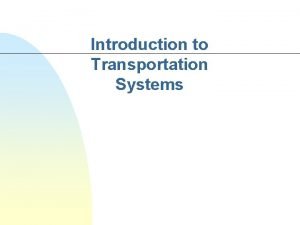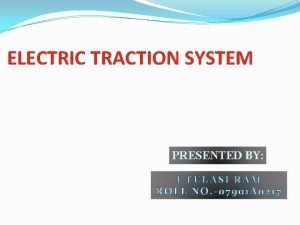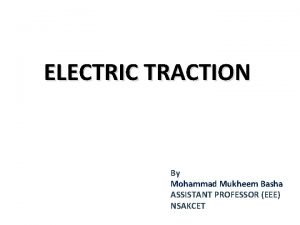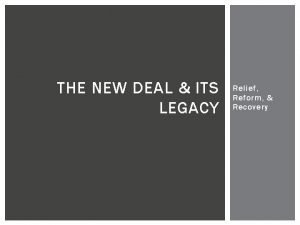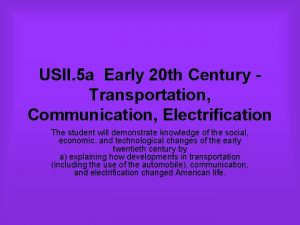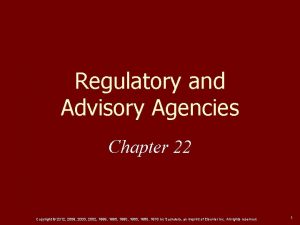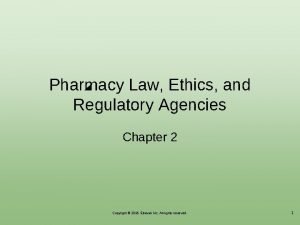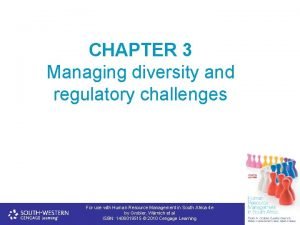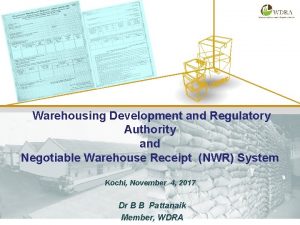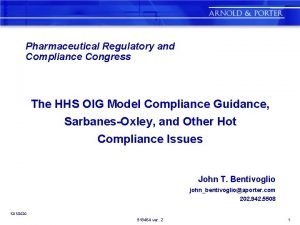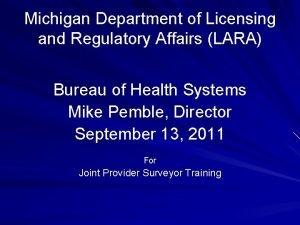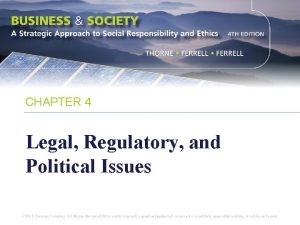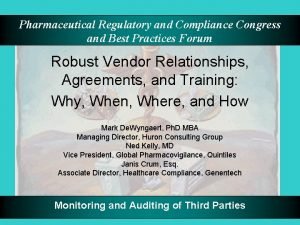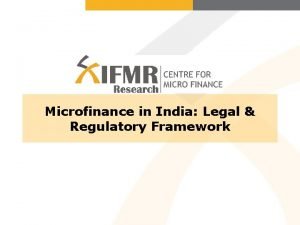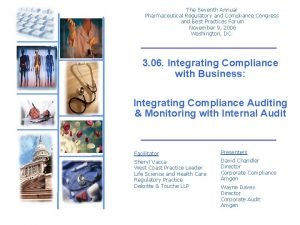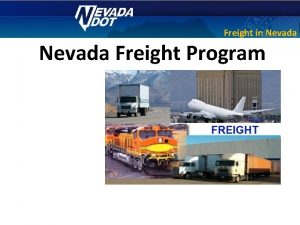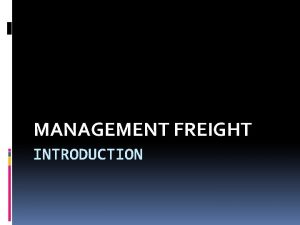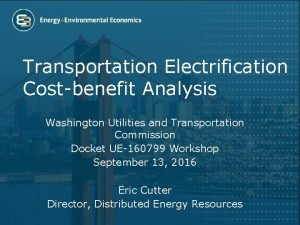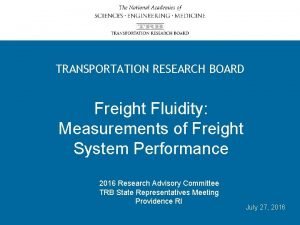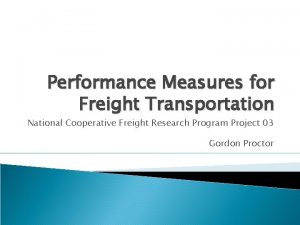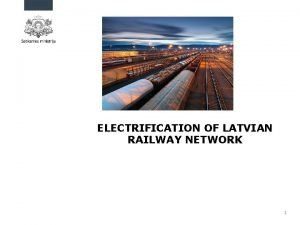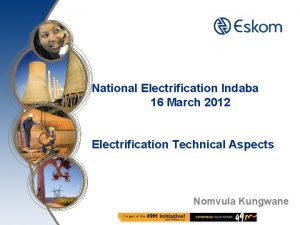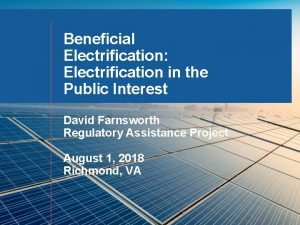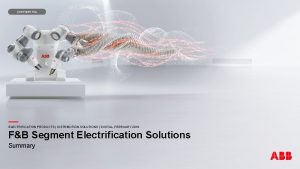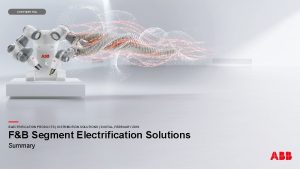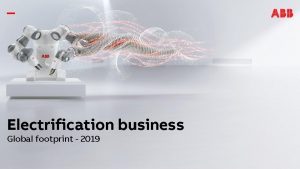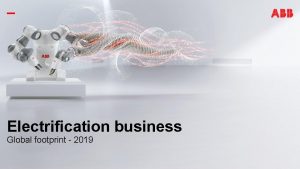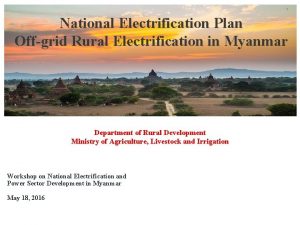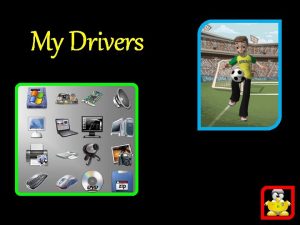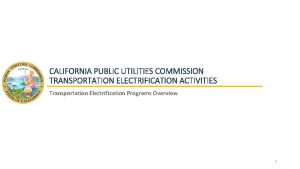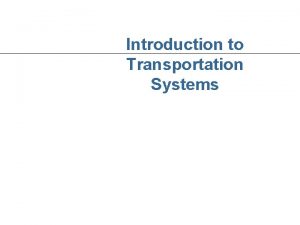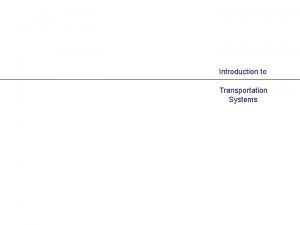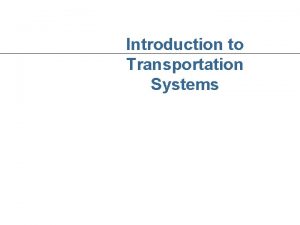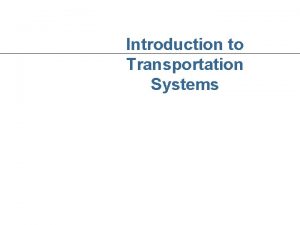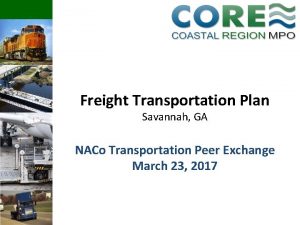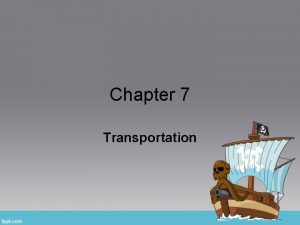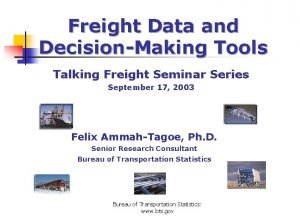Regulatory Drivers for Transportation Electrification of Freight and



























- Slides: 27

Regulatory Drivers for Transportation Electrification of Freight and Off-Road Equipment California Energy Commission Workshop on Electric Vehicle Charging Infrastructure Assessment (AB 2127) May 2, 2019, 1: 30 PM

Part I: Mobile Source Strategy Integrated strategy for multiple goals 2

California’s Air Quality and Climate Goals Federal Air Quality Standards Community Risk Reduction Greenhouse Gas Reduction Targets 2023/ 2030/2031 Renewable Energy Targets 5 Million Zero Emission Vehicles Petroleum Reduction Target 3

Mobile Source Reductions are Key • Largest Contributor to smogforming, greenhouse gas and diesel particulate matter (DPM) emissions • Within mobile sources • GHG- light duty passenger vehicles • NOx & DPM – heavy duty trucks & off-road 4

GHG Emissions https: //www. arb. ca. gov/cc/inventory/data. htm https: //www. arb. ca. gov/cc/inventory/pubs/reports/2000_2016/ghg_inventory_trends_00 -16. pdf 5

Statewide NOx Emissions, 2018 CEPAM statewide NOx Emission Inventory includes OGV out to 100 nautical miles https: //www. arb. ca. gov/app/emsinv/fcemssumcat 2016. php 6

Statewide DPM Emissions, 2018 CEPAM statewide PM 10 Emission Inventory includes OGV out to 100 nautical miles https: //www. arb. ca. gov/app/emsinv/fcemssumcat 2016. php 7

Mobile Source Strategy • An integrated planning process • Understand emission contributions and existing regulations/standards • Technology assessments identify status of advanced technologies and fuels • Consider how actions can best meet multiple goals • Scenario analysis provides framework for coordinated air quality and climate assessment 8

Key Strategy Actions Identified • Light duty passenger vehicle • Zero emission technologies • Curb growth in vehicle miles travelled • Heavy duty sectors (including on and off-road) • Near-zero emission technologies operate on renewable fuels • Zero emission technologies • Electrification • Fuel cell 9

Part II: Freight Goals, Existing Strategies, and Future Actions 10

CARB Freight and Off-Road Actions Designed to Meet Multiple Objectives Cut community health risk (support AB 617 emission reductions) Attain regional air standards (support State Implementation Plan) Mitigate climate change (support Scoping Plan and SLCP Plan) 11

Freight Strategies Already Implemented to Cut Emissions and Health Risk Trucks • Fuel/engine Ships • Fuel • In-use trucks/ • At berth turnover reductions • GHG limits • Idling and smoke limits • In-use compliance • Ship incinerator ban Locomotives Equipment Harbor Craft • Fuel/engine • Fuel • Fleet emission limits for South Coast • Port & rail equipment • Harbor craft engines • Diesel soot reduction at rail yards • Forklifts • Airport equipment • Transport refrigerators 12

Progress in Reducing Freight Emissions Statewide, 2000 -2035 13

Need for Zero-Emission Infrastructure Planning • Zero and near-zero technologies in heavy-duty, freight, and off-road sectors are critical to achieve air quality goals • Grid-connected and battery-electric technologies will likely play a major role to achieve zero-emission targets • Infrastructure needs, charging standards/connections, and power capacity needs vary widely, and are under various stages of development by source category 14

Data Collection Opportunities for AB 2127 Assessment • CARB Technology Assessments (2015 -2018) https: //ww 2. arb. ca. gov/resources/documents/technology-and-fuels-assessments • Findings from CEC and CARB funded advanced technology demonstration projects • CPUC data collection for utility transportation electrification projects • Tracking assessments lead by ports on terminal/equipment electrification (e. g. San Pedro Bay Ports Clean Air Action Plan) 15

Selected CARB Regulatory Actions with Current or Potential Future Requirements for Electrification • • • Ships At-Berth Transport Refrigeration Units Harbor Craft Cargo Handling Equipment Locomotives Heavy-Duty Trucks Forklifts Airport Ground Support Equipment (GSE) Airport Shuttle Buses 16

Ships At Berth Typical uses: Vessel types include container, reefer, cruise, auto carrier, and tanker vessels Population ~1250 unique ocean going vessels, and new regulation will likely require an ~85 additional container, cruise, or refrigerated cargo vessels expected to comply using shore power Concepts Reduce at berth emissions by controlling more visits, vessel types, and ports Timeline Phase-in anticipated 2021 to 2029 Electric Infrastructure Needs Electrical demands at berth vary per vessel type: container, reefer, and auto carrier ~1 MW, cruise ~3 -11 MW, tankers ~0. 5 -2. 5 MW Shore Power 17

Harbor Craft Typical uses: passenger and freight vessels, such as ferries, tugboats, barges, dredges Population ~3, 500 vessels Concepts Focus on cleaner combustion but support introduction of zero-emission technologies where feasible Timeline Phase-in anticipated to begin in 2023 Electric Additional electrification expected to Infrastructure support augmented use of shore power Needs and charging for emerging full zeroemission or “plug-in hybrid” diesel vessels with battery storage 18

Transport Refrigeration Units Typical uses: Provide climate control for ocean-going and domestic containers, box trucks, rail cars, and truck transported refrigerated trailers. Population ~200, 000 TRUs and generator sets. Concepts Require Trucks to use 100% zero-emission TRUs, Trailer TRUs to be zero when stationary, and facilities to provide infrastructure to allow for zero-emission operation on-site. Timeline Phase-in anticipated to begin in 2025 Electric Infrastructure Needs Substantial. Up to 10, 000 facilities (warehouses, stores, truck stops, etc. ) may need to install electric (or other zero-emission technology) infrastructure. Truck TRU Trailer TRU 19

Cargo Handling Equipment Typical uses: Moving container, bulk, or liquid cargo at ports and intermodal rail yards Population ~5, 000 pieces of equipment statewide Concepts Transition to full zero-emission technologies Timeline Phase-in anticipated to begin in 2026 Electric Infrastructure Needs Under development - considerations include charging rate required for battery electric equipment, and use of electric versus other zero-emission alternatives. 20

Part III: Zero-Emission Vehicle and Off-Road Programs Current and Future Actions 21

Advanced Clean Trucks (ACT) & Zero-Emission (ZE) Fleet Rules Typical uses Pickup and delivery, drayage, utility, refuse, public, shuttle, others Population ~70, 000 ZE trucks or more by 2030 Concepts • ZE trucks as a percent of manufacturers sales • Future fleet rules/other policies Timeline ACT and fleet rules: Implementation 2024+ Electrical Overnight depot charging initially Infrastructure Public fast-charging network later on Needs 22

Airport shuttle Typical uses: Transport passengers around airport property and between airports and nearby businesses (e. g. hotels, offairport parking) Population ~1, 000 shuttles Concepts Fully transition to zero-emission technologies Timeline 2027 to 2035 Electric Majority of chargers will be 50 k. W and Infrastructure above. This will likely require Needs infrastructure upgrades at all regulated airports and most regulated businesses. 23

Airport GSE Typical uses: Transport baggage, cargo, and passengers to and from aircraft; move, service and provide ground power to aircraft Population >7, 000 pieces of equipment Concepts Accelerate transition to zero-emission GSE Timeline Board Hearing: September 2020 Implementation 2023 to 2031 Electric Charging rates up to 80 k. W or more Infrastructure (e. g. , multiport, multi-equipment charger) Needs with a significant variation in charging demands for different types of GSE 24

Forklifts Typical uses: Warehousing, distribution centers, ports, manufacturing Population ~100, 000 (~50% new purchases are electric) Concepts Require fleets of forklifts (<8, 000 lb. ) to transition to zero-emission technology Timeline Implementation 2023 -2035 Electric Infrastructure Needs Worksite-specific charging needs; Conventional (5 k. W) and Fast-charging (30+ k. W) options 25

Next Steps • Continue consultation with CEC pursuant to AB 2127 electric vehicle charging assessment • Maintain focus on developing zero-emission in-use and zero-emission equipment manufacturer requirements • Expand equipment standard development to include focus on connection standards, projections of energy demands, and identifying charging locations • Collaborate and engage facilities, utilities, and other agencies in zero-emission planning discussions 26

Contact Information Kathy Jaw, Manager Sustainable Transportation and Communities Division Kathy. Jaw@arb. ca. gov (916) 322 -1720 David Quiros, Manager Transportation and Toxics Division David. Quiros@arb. ca. gov (916) 327 -7213 Craig Duehring, Manager Mobile Source Control Division Craig. Duehring@arb. ca. gov (916) 323 -2361 27
 Drivers ed chapter 2 signs signals and roadway markings
Drivers ed chapter 2 signs signals and roadway markings Freight transportation 2
Freight transportation 2 State various types of track electrification system
State various types of track electrification system Kando system of track electrification
Kando system of track electrification Relief, recovery, reform
Relief, recovery, reform Ways electrification changed american life
Ways electrification changed american life Chapter 22 regulatory and advisory agencies
Chapter 22 regulatory and advisory agencies Chapter 2 pharmacy law ethics and regulatory agencies
Chapter 2 pharmacy law ethics and regulatory agencies Diversity and regulatory challenges
Diversity and regulatory challenges Warehousing development and regulatory authority
Warehousing development and regulatory authority Pharmaceutical regulatory and compliance congress
Pharmaceutical regulatory and compliance congress Michigan licensing and regulatory affairs
Michigan licensing and regulatory affairs Legal regulatory and political issues
Legal regulatory and political issues Pharmaceutical regulatory and compliance congress
Pharmaceutical regulatory and compliance congress Legal and regulatory framework of microfinance in india
Legal and regulatory framework of microfinance in india Pharmaceutical regulatory and compliance congress
Pharmaceutical regulatory and compliance congress Pharmaceutical regulatory and compliance congress
Pharmaceutical regulatory and compliance congress Formuö
Formuö Typiska drag för en novell
Typiska drag för en novell Nationell inriktning för artificiell intelligens
Nationell inriktning för artificiell intelligens Ekologiskt fotavtryck
Ekologiskt fotavtryck Varför kallas perioden 1918-1939 för mellankrigstiden
Varför kallas perioden 1918-1939 för mellankrigstiden En lathund för arbete med kontinuitetshantering
En lathund för arbete med kontinuitetshantering Personalliggare bygg undantag
Personalliggare bygg undantag Tidbok
Tidbok Sura för anatom
Sura för anatom Densitet vatten
Densitet vatten Datorkunskap för nybörjare
Datorkunskap för nybörjare

